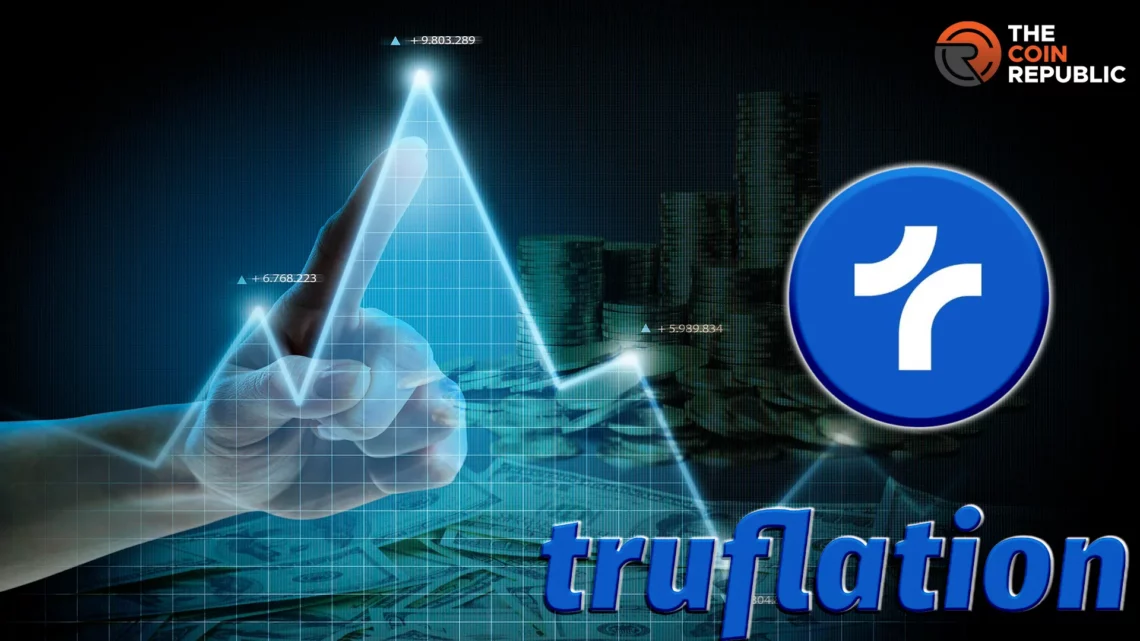Discover Truflation, the real-time inflation data service is revolutionizing economic insights. Despite challenges, Truflation sparks vital debates about the future of inflation data in our ever-changing economy.
Truflation is a blockchain-powered financial data service that delivers real-time economic and inflation data. It was launched in December 2021, and its methodology is updated annually. It also provides daily inflation updates from more than 30 sources.
Despite experiencing a deficit, Truflation is growing its customer base and income, focusing on crucial KPI conversion, and issuing its coin in January 2024.
Let’s get deep into it.
Overview
Truflation is an innovative financial data service that provides real-time economic and inflation data via blockchain technology. This platform was created to give more accurate and accessible inflation statistics than previous approaches, such as the Consumer Price Index (CPI).
Truflation, which began with its maiden reports in December 2021, is an impartial data service that provides real-time inflation calculations. Unlike the CPI, produced by the Bureau of Labor Statistics (a U.S. government agency), Truflation is a private business that updates its methodology annually, using modern consumer and expenditure data and advanced technology.
Core Features And Technology
- Daily inflation updates are one of Truflation’s core value propositions. The Truflation dataset is updated daily from several sources across all inflation categories, providing a more dynamic view of inflation than the CPI’s monthly updates. This real-time data provision reduces market uncertainty by regularly updating consumer price changes.
- Truflation collects data from over 30 sources, totaling millions of product pricing data points. This contrasts with the usual CPI statistic, which incorporates data from around 80,000 goods. Truflation’s data collecting strives to represent the market accurately.
- Categorization of Consumer Prices: The consumer prices in Truflation’s calculation are divided into twelve categories, each with a relative expenditure weight. These sections provide a detailed look at several inflation sectors, such as food and beverages, housing, utilities, and transportation.
- Truflation’s data sources include significant companies such as NielsenIQ, the Big Mac Index, Amazon, Walmart, Zillow, and others. This extensive network enables the speedy collection of pricing information from independent sources.
Truflation vs. CPI: A Tale Of Two Metrics
The Consumer Price Index (CPI) has long been the gold standard for measuring inflation. It tracks the average price changes of a basket of goods and services essential for everyday living. However, critics argue that the CPI may not fully capture the true impact of inflation on modern consumers.
Here’s a breakdown of the key differences:
Data Collection:
CPI: Relies on a fixed basket of goods and services, updated every two years, which may not always reflect evolving consumer preferences.
Truflation is a dynamic approach that gathers data from over 30 sources, including traditional and alternative datasets, to capture changing consumer behavior more comprehensively.
Frequency:
CPI: Reports monthly but reflects past price changes, providing a historical view of inflation trends.
Truflation offers real-time updates, allowing users to see price changes as they happen and providing more immediate insights into inflation’s impact.
Methodology:
CPI: Uses a well-established methodology but updates less frequently, potentially missing rapid changes in consumer behavior and substitution patterns.
Truflation: Methodology is evolving with annual updates to adapt to changing economic conditions, aiming to capture emerging trends but raising concerns about data consistency and comparability.
By simplifying these points, we can understand how CPI and Truflation differ in their measuring of inflation.
The Potential Impact of Truflation
Truflation’s unique approach has the potential to impact various stakeholders:
- Investors: Truflation can help you pick suitable investments and adjust your portfolio as prices change.
- Businesses: Businesses can use Truflation to set better prices and manage costs to stay profitable during inflation.
- Policymakers: Governments can use Truflation data to make better decisions about taxes, spending, and interest rates to fight inflation.
- Individuals: Truflation can help you budget better, save more brilliantly, and make informed choices when shopping.
Truflation offers a more dynamic way to understand inflation, potentially giving everyone a leg up in these uncertain times.
The Road Ahead: Challenges and Considerations
While Truflation offers a promising alternative, it’s essential to acknowledge the challenges it faces:
Data Dilemmas
Truflation’s strength lies in its diverse data sources. However, the accuracy of its final inflation figures hinges on the reliability of each source. Here’s the breakdown:
- Source Credibility: Truflation incorporates data from over 30 sources, including social media sentiment analysis. If any of these sources are unreliable or biased, it can pollute Truflation’s data pool, leading to inaccurate inflation readings.
- Data Cleaning Challenges: With such a vast amount of data from varied sources, ensuring its consistency and accuracy requires robust data cleaning techniques. To maintain user trust, truflation must effectively address outliers, inconsistencies, and potential biases within the data.
Methodology Mystery
Truflation emphasizes transparency, but its evolving methodology presents a unique challenge:
- Methodological Maze: Truflation updates its data collection and calculation methods annually to adapt to changing consumer behavior. While this ensures adaptability, frequent changes can make it difficult for users to understand how Truflation arrives at its final inflation figures. This lack of clarity might raise concerns about the replicability and reliability of Truflation’s data.
- Building User Trust: Without a clear understanding of the underlying calculations, users might hesitate to trust Truflation’s data fully. To build user confidence, Truflation needs to find a way to balance its innovative and evolving methodology with clear and consistent communication.
Regulatory Riddles
Truflation leverages blockchain technology, which operates outside traditional financial structures. This presents a regulatory hurdle:
- Regulatory Uncertainty: Integrating a blockchain-based system into the established financial infrastructure might require adjustments to existing regulations. Regulatory bodies may need to establish clear guidelines for how blockchain-based data like Truflation’s interacts with traditional financial data. This process can be slow and complex, potentially hindering Truflation’s widespread adoption.
These challenges need to be addressed for Truflation to reach its full potential.
Conclusion
Truflation offers an appealing idea of a more dynamic and data-driven approach to understanding inflation. However, it is unclear whether it will become the primary method or supplement existing systems.
However, Truflation has spurred debate about the future of inflation data and its place in a continually changing economic world.
As we move forward, we will need to critically evaluate both traditional and creative methods, such as Truflation, to guarantee we have the most accurate and insightful tools for navigating the complexity of inflation in the twenty-first century.

Amanda Shinoy is one of the few women in the space invested knee-deep in crypto. An advocate for increasing the presence of women in crypto, she is known for her accurate technical analysis and price prediction of cryptocurrencies. Readers are often waiting for her opinion about the next rally. She is a finance expert with an MBA in finance. Quitting a corporate job at a leading financial institution, she now engages herself full-time into financial education for the general public.


 Home
Home News
News







